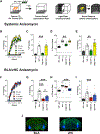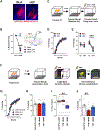Dissociable contributions of the amygdala and ventral hippocampus to stress-induced changes in defensive behavior
- PMID: 39427320
- PMCID: PMC11849735
- DOI: 10.1016/j.celrep.2024.114871
Dissociable contributions of the amygdala and ventral hippocampus to stress-induced changes in defensive behavior
Abstract
Stress can have profound consequences on mental health. While much is known about the neural circuits supporting associative memories of stressful events, our understanding of the circuits underlying the non-associative impacts of stress, such as heightened stress sensitivity and anxiety-related behavior, is limited. Here, we demonstrate that the ventral hippocampus (vHC) and basolateral amygdala (BLA) support distinct non-associative behavioral changes following stress. Inhibiting stress-induced protein synthesis in the BLA blocked subsequent increases in stress sensitivity but not anxiety-related behaviors. Conversely, inhibiting stress-induced protein synthesis in the vHC blocked subsequent increases in anxiety-related behavior but not stress sensitivity. Inhibiting neuronal activity in the BLA and vHC during the assessment of stress sensitivity or anxiety-related behavior recapitulated these structures' dissociable contributions to defensive behavior. Lastly, blocking the associative memory of a stressor had no impact on stress-induced changes in anxiety-related behavior. These findings highlight that multiple memory systems support the long-lasting effects of stress.
Keywords: Amygdala; CP: Neuroscience; anxiety; fear; hippocampus; non-associative learning; plasticity; sensitization; stress; stress-enhanced fear learning; trauma.
Copyright © 2024 The Author(s). Published by Elsevier Inc. All rights reserved.
Conflict of interest statement
Declaration of interests The authors declare no competing interests.
Figures




Update of
-
Dissociable contributions of the amygdala and ventral hippocampus to stress-induced changes in defensive behavior.bioRxiv [Preprint]. 2024 May 8:2023.02.27.530077. doi: 10.1101/2023.02.27.530077. bioRxiv. 2024. Update in: Cell Rep. 2024 Nov 26;43(11):114871. doi: 10.1016/j.celrep.2024.114871. PMID: 36945605 Free PMC article. Updated. Preprint.
References
-
- Fendt M, and Fanselow MS (1999). The neuroanatomical and neurochemical basis of conditioned fear. Neurosci. Biobehav. Rev. 23, 743–760. - PubMed
-
- Bolles RC (1970). Species-specific defense reations and avoidance learning. Psychol. Rev. 77, 32–48.
-
- Fanselow MS, and Lester LS (1988). A functional behavioristic approach to aversively motivated behavior. In Evolution and Learning, Bolles RC and Beecher MC, eds. (Erlbaum; ), pp. 185–211.
-
- Cannon WB (1915). Bodily Changes in Pain, Hunger, Fear and Rage: An Account of Recent Researches into the Function of Emotional Excitement (D. Appleton and Componay; ).
Publication types
MeSH terms
Grants and funding
LinkOut - more resources
Full Text Sources
Medical
Miscellaneous

